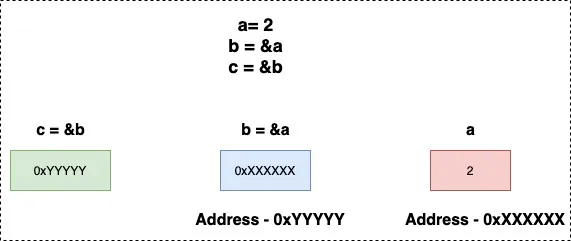Home >Backend Development >Golang >Detailed explanation of 11 knowledge points about pointers in Go language
Detailed explanation of 11 knowledge points about pointers in Go language
- 青灯夜游forward
- 2022-10-27 19:19:093312browse
Pointers are one of the most important parts of writing good code. In this article, we will explore what pointers are and how to use them in Go.

#1. What is a pointer
A pointer is a variable that stores the address it points to (emphasis on, Just a variable that stores a numeric value). [Related recommendations: Go Video Tutorial]
A pointer of a specific type can only point to that type (the data type pointed to by the pointer is immutable).
2. GoLang pointer syntax
The syntax of pointers is very simple. Following is the syntax for pointer declaration in Go.
var ptr *type var ptrint *int // 指向 int 的指针
The zero value of a pointer is nil.
3. Initialization of pointers in Go
type pointers are initialized using &:
package main
import (
"fmt"
)
func main() {
var q int = 42
var p *int // declare the pointer
p = &q // initialize the pointer
fmt.Println(p) // 0x40e020
}4. Go pointer value
Pointer value means getting the value in the address saved by the pointer. The following is an example of using the * operator to perform pointer value operations:
package main
import (
"fmt"
)
func main() {
var q int = 42
var p *int
p = &q
fmt.Println(p) // 0x40e020
fmt.Println(*p) // 42
}5. Pointers to pointers in GoLang
The address of the pointer is a numerical value, and this numerical value can also be assigned to other variables. Therefore, we can create levels of indirection. These levels of indirection can sometimes create unnecessary confusion, so use them with caution.
package main
import (
"fmt"
)
func main() {
i := 64
j := &i // j 是 int 类型的指针
k := &j // k 是存放指针地址的指针,也是 int 类型
fmt.Println(i) // 64
fmt.Println(j) // 0x40e020
fmt.Println(*j) // 64 (value inside that address)
fmt.Println(k) // 0x40c138
fmt.Println(*k) // 0x40e020 (address of j)
}6. Pointers to interfaces
Pointers can point to anything, even to interfaces. When using the empty interface, the returned value is nil.
package main
import (
"fmt"
)
func main() {
var a interface{}
b := &a
fmt.Println(b) // 0x40c138
fmt.Println(*b) // <nil>
}The following is an example of using an interface with pointers.
package main
import (
"fmt"
)
// 定义接口
type Bird interface{
fly()
}
type B struct{
name string
}
// 实现它
func (b B)fly() {
fmt.Println("Flying...")
}
func main() {
var a Bird = B{"Peacock"}
b := &a
fmt.Println(b) // 0x40c138
fmt.Println(*b) // {Peacock}
}Here "a" is a struct type Bird, which is then used for the interface type, as you can see. This is the use of polymorphism. Go allows polymorphism to be achieved using interfaces. Therefore, you can see that pointers to structures or interfaces are an essential tool in Go.
7. Pointers as function parameters
Pointers can be used as parameters infunctions . It has some advantages over using values directly. Using pointers as arguments is a very efficient way of passing large objects to functions . So using it is a huge optimization.
package main
import (
"fmt"
)
//声明指针参数
func f(a *int) {
fmt.Println(*a)
}
func main() {
var a int = 42
// 传递地址
f(&a) // 42
}Using large objects can slow down execution time, here is an example of passing a pointer to a structure. This is an efficient way to handle large objects. package main
import (
"fmt"
)
type Human struct {
name string
age int
place string
}
func f(h *Human) {
fmt.Println("The user", (*h).name, "is", (*h).age, "years old and he is from", (*h).place)
}
func main() {
john := Human{"John", 36, "Las Vegas"}
f(&john) // The user John is 36 years old and he is from Las Vegas
}Be careful when dereferencing structures. If you use it like *structname.field1 then it will throw error. The correct method is (*structname).field1.
mutable" unless its parameter is const, so whenever we want to change a value, We should use a pointer to the value as a function parameter and then modify it as necessary.
8. The "new" function in Go
Thenew function in Go returns a pointer to a type.
package main
import (
"fmt"
)
func main() {
ptri := new(int)
*ptri = 67
fmt.Println(ptri) // 0x40e020
fmt.Println(*ptri) // 67
}
9. Returning pointers from functions
You can return pointers of any type from functions just like other values. It's really simple. We don't return the value directly, but the address of the value.package main
import (
"fmt"
)
func p() *int { // 将返回类型指定为指针
v := 101
// 返回地址
return &v
}
func main() {
n := p()
fmt.Println(n) // 0x40e020
fmt.Println(*n) // 101
}
10. Pointers to functions
Pointers to functions work implicitly in Go. This means we don't need to declare it as a pointer.package main
import (
"fmt"
)
func main() {
f := func() {
fmt.Println("a function")
}
pf := f
pf() // 一个函数
}
11. Things to remember when using pointers in Go
Pointer arithmetic is not allowed in Go. Therefore, we cannot perform operations like unary increment or decrement as we can in C/C.We might want to use a pointer to an array, but using a slice is a better option. Slices are much more versatile than pointers to arrays. The code is very concise and makes our work easier. Therefore, use slices whenever possible.
Programming Video! !
The above is the detailed content of Detailed explanation of 11 knowledge points about pointers in Go language. For more information, please follow other related articles on the PHP Chinese website!

